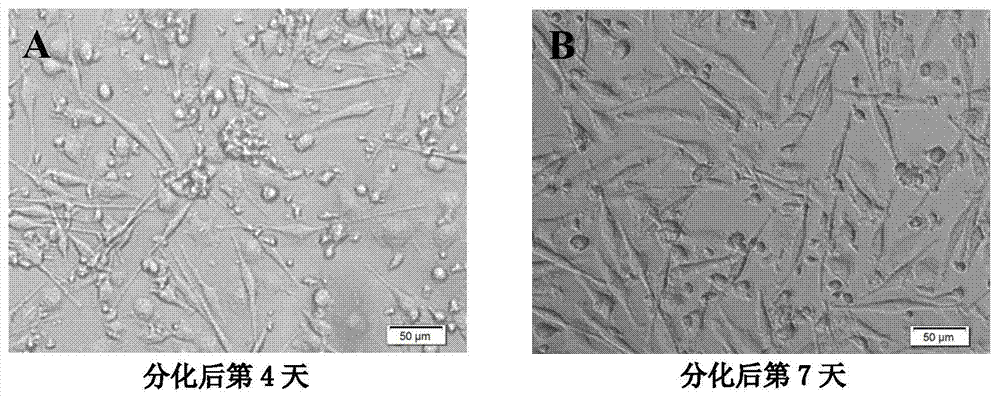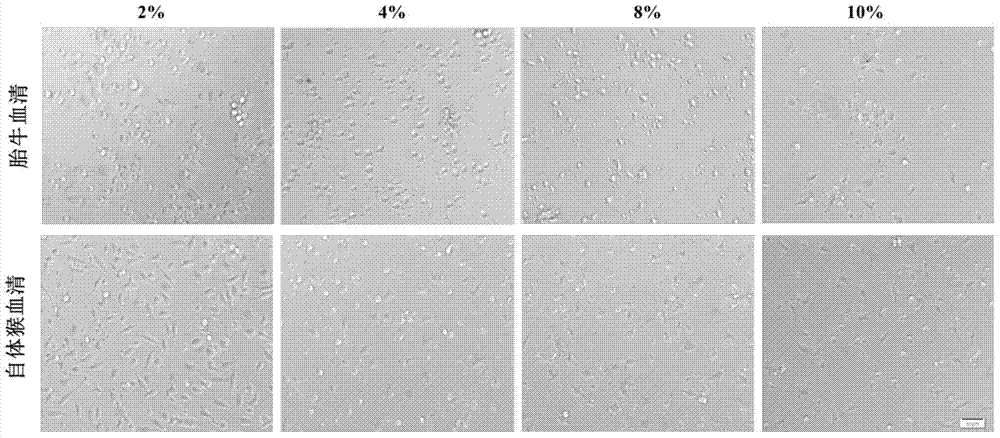Culture method and application thereof for rhesus peripheral blood mononuclear macrophages
A technology of macrophages and peripheral blood, applied in the field of cell biology, to achieve the effect of less steps, less interference and less pollution
- Summary
- Abstract
- Description
- Claims
- Application Information
AI Technical Summary
Problems solved by technology
Method used
Image
Examples
Embodiment 1
[0033] [Example 1] Isolation and culture of rhesus monkey peripheral blood mononuclear macrophages
[0034] Intramuscularly anesthetize healthy adult (4-5 years old) Chinese rhesus monkeys with ketamine (10mg / kg), collect 5-10ml of venous blood with heparin sodium anticoagulant vacuum blood collection tubes and non-anticoagulant vacuum blood collection tubes respectively 5ml of whole blood was collected. Anticoagulated blood was used for the separation of PBMCs, and non-anticoagulated blood was used for the separation of monkey serum after self-coagulation. Dilute anticoagulated whole blood (5-10ml) with phosphate buffered saline (PBS), then slowly add to the upper layer of lymphocyte separation medium (Ficoll) that diluted 1 / 2 volume of the blood, and centrifuge at 1800rpm / min at 22°C for 30 minutes , Aspirate the layer of PBMCs between the plasma dilution and Ficoll. The collected cells were resuspended and washed twice with an equal volume of PBS, and the washed cells wer...
Embodiment 2
[0035] [Example 2] Identification of cultured rhesus monkey peripheral blood mononuclear macrophages by flow cytometry
[0036] Rhesus mononuclear macrophages on the 4th and 7th day of differentiation culture were first washed 3 times with PBS, digested with 0.25% trypsin for 5 minutes until most of the cells shrank and became round, and then added with 2% autologous monkey serum The complete medium terminates the digestion, the cells are suspended by pipetting, and the cells are collected. Continue to wash 2 times with PBS, then add 50 μl PBS to resuspend to make a single cell suspension, and add 2 μl of CD14-Percp-Cy5.5 (BD, USA) antibody, and add 2 μl of isotype (Isotype) antibody IgG2-Percp to the negative control tube -Cy5.5 (BD, USA), incubate at 4°C in the dark for 15 minutes, wash twice with PBS, remove excess antibody, add fixative (2% paraformaldehyde) to resuspend cells, and use flow cytometry (BD FACS Verse, USA) to detect the expression level of CD 14 on the cell...
Embodiment 3
[0037] [Example 3] Effects of different concentrations of monkey autologous serum or fetal bovine serum on the differentiation of rhesus monkey mononuclear macrophages
[0038] Place 96 wells (0.8×10 6 cells / well) or 48 wells (3×10 6 cells / well) monkey PBMCs in the culture plate, the non-adherent cells were washed away after 24 hours, and the pictures were taken after continuing to culture for 7 days. Such as image 3 As shown (the scales of all the figures in the figure are the same), the monkey autologous serum is better than the fetal calf serum, and the low-proportion autologous serum is better than the high-proportion serum for the differentiation of rhesus monkey mononuclear macrophages. As the serum ratio decreased, the adherent cells increased, and the morphology of differentiated macrophages was highly consistent. Under RPMI 1640 culture conditions containing 2% monkey autologous serum, most (>85%) monocytes could adhere to the wall and differentiate into macrophag...
PUM
 Login to View More
Login to View More Abstract
Description
Claims
Application Information
 Login to View More
Login to View More - R&D
- Intellectual Property
- Life Sciences
- Materials
- Tech Scout
- Unparalleled Data Quality
- Higher Quality Content
- 60% Fewer Hallucinations
Browse by: Latest US Patents, China's latest patents, Technical Efficacy Thesaurus, Application Domain, Technology Topic, Popular Technical Reports.
© 2025 PatSnap. All rights reserved.Legal|Privacy policy|Modern Slavery Act Transparency Statement|Sitemap|About US| Contact US: help@patsnap.com



